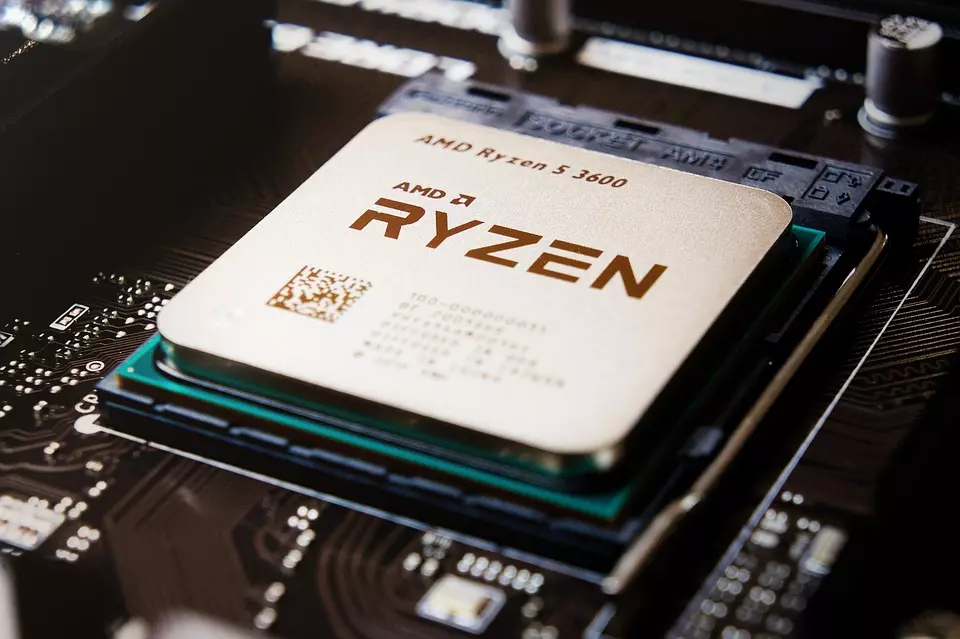AMD’s new processors have arrived – and they’re stunning. Here’s a guide to what’s changed, and which Chillblast systems are locked and loaded with the red team’s latest silicon.
It’s been a bumper couple of years for AMD since they released the original Ryzen processors, and now the third generation of Ryzen chips has landed.
These new parts have a radically different design, with more cores and better speeds, and they’re joined by a new chipset – and a range of new Chillblast systems, too.
We’ve gone in-depth about what’s new – and we’ve also explained the range, the performance you should expect, and the X570 chipset.

A State of Zen 2
The architecture inside Ryzen 3000 CPUs is called Zen 2, and it makes big changes.
The first big improvement is a move from a 14nm manufacturing process to a 7nm design. AMD has beaten Intel to the punch and this development means Zen 2 CPUs include more transistors that use less electricity – so there’s an immediate performance jump while efficiency remains virtually unchanged.
New Chiplets Design
The second significant improvement comes with how AMD arranges cores. The chips are now built from ‘chiplets’, with each including six or eight cores – rather than cores being installed in smaller groups. The chiplets are multi-threaded, so six or eight-core chiplets can address twelve or sixteen threads.
AMD’s reliance on chiplets mean modular CPUs. AMD’s six or eight-core Ryzen 3000 chips only use one chiplet, for instance, but twelve or sixteen core CPUs use two to deliver their increased core counts.
This move means AMD can build CPUs with more ease and efficiency than before – so prices can be reduced across the range.

Separate IO die
These chiplets aren’t the only area of Zen 2 where modularity has come to the fore. AMD’s new chips have another separate die that hold all of the CPU’s IO functions.
This chip uses a 12nm manufacturing process, not 7nm – fine for this hardware, and easier and cheaper for AMD to build. The separate IO die helps reduce the size and complexity of every part of the CPU. The IO dies can also interact with multiple chiplets, so only one IO die is needed per CPU.
These top-level changes give AMD’s CPUs several advantages. The move to 7nm means an instant performance and efficiency boost, and the use of chiplets makes it easier and cheaper for AMD to build CPUs. Similarly, the separate IO dies make that part of the processor cheaper to build, and with better yields.
Other Improvements
Those are the headline changes, but they’re not AMD’s only enhancements. There’s more L3 cache (small pools of memory that store information the CPU is most likely to need next) and the new parts support PCI-Express 4.0 – which means faster SSDs and better graphics card bandwidth.
PCI-E 4.0 SSDs are beginning to arrive, and AMD has beaten Intel to the punch here.
Elsewhere, an improvement to Precision Boost means the new CPUs get a better upper limit for automatic overclocking, and the chips are quicker to switch clock speeds – and speeds change in 25Hz increments. Intel’s CPUs respond more slowly, and in 100Hz jumps, so AMD has a versatility advantage.
Range-Finding
Ryzen 9
AMD has released five new Ryzen 3000 CPUs – starting with the current flagship, the Ryzen 9 3900X.
It’s AMD’s first mainstream twelve-core CPU, and is the only one in the range that is built using two chiplets. That also means it has 64MB of cache – twice as much as any of the other Zen 2 parts.
It’s clocked to 3.8GHz with a Boost speed of 4.6GHz, and it competes with the Intel Core i9-9920X. Intel’s 12-core CPU has speeds of 3.5GHz and 4.5GHz, so AMD’s part looks impressive. And, even better, the AMD chip is cheaper: the Ryzen 9 3900X has a price of £480, while Intel’s CPU sits at a whopping £1,250.
Ryzen 7
The next step down the range reveals two Ryzen 7 chips. The Ryzen 7 3700X and Ryzen 7 3800X are eight-core parts with 32MB of cache. The 3700X is clocked to 3.6GHz and 4.4GHz, and the 3800X runs at 3.9GHz and 4.5GHz.
These parts cost £320 and £380 respectively, and they’re designed to compete with Intel’s Core i7-9700K and i9-9900K. The Core i7-9700K has a slightly better boost clock than the 3700X, but it has no multi-threading and it costs £360. The Core i9-9900K does have multi-threading, so it matches the 3800X there, and it also has a better boost clock – but its base speed is slower, and it costs £499.

Ryzen 5
Next, you’ll find two Ryzen 5 chips. The Ryzen 5 3600 and 3600X are six-core chips with multi-threading, and they cost £189 and £229. In terms of speeds, they trade blows with the Core i5-9600K, but Intel’s CPU has six cores without multi-threading and it costs £275.
So, while AMD and Intel chips compete closely in clock speeds, AMD’s new chips are always cheaper than their rivals – and they usually have support for many more threads.
In terms of performance, AMD expects around 15% improvement in single-threaded tasks when compared to older Ryzen chips, with a larger gap in multi-threaded tasks. AMD claims similar gaps when compared to equivalent Intel chips in multi-threaded applications. That’s going to be especially important for creative tasks and for productivity applications.
The new parts are not hugely different from Intel chips in single-threaded tasks or gaming. While you may not get a big advantage there in terms of raw performance, AMD often beats or matches Intel while coming in a lot cheaper – and that’s impressive.
The X570 Ecosystem
AMD is introducing a new X570 chipset alongside Ryzen 3000, which means new motherboards too.
The X570 chipset supports twelve USB ports, including eight USB 3.1 Gen 2 ports – which means better speeds. Memory support has been upgraded to 3,200MHz, and X570 supports sixteen PCI lanes.
You also get 12 SATA and SATA Express lanes, which is twice as many as older chipsets. And, as we’ve mentioned before, there’s PCI-Express 4.0 support – something which Intel doesn’t have.
It’s a good upgrade in the key departments, but the X570 chipset has a peak power requirement of 15W – three times as high as older AMD chipsets. That means more heat, which means new motherboards will have larger, heavier heatsinks – and some will also have fans.
The increased cooling requirements and the addition of new technology may mean that motherboard prices rise a little when compared to older AMD hardware and equivalent Intel boards.
Blasting to the Future
Chillblast has released three high-octane rigs with new AMD Ryzen 3000 processors.
Fusion Ryzen 9 3950X

The first, the Fusion Ryzen 9 3950X, is a beast. As the name suggests, it features the flagship AMD Ryzen 9 3950X – which means you get a monster twelve cores, 64MB of cache and a boost speed of 4.6GHz.
The processor will scythe through work tasks with more multi-threaded performance than Intel’s equivalents, and the rest of the specification is fearsome. The CPU attaches to an Asus Strix X570-F Gaming motherboard, and graphical power comes from an Nvidia GeForce RTX 2080 Ti – one of the most powerful GPUs on the planet.
Elsewhere, there’s a 500GB Samsung SSD and a 2TB secondary SSD, 16GB of 3,200MHz memory, Corsair liquid cooling and a Fractal Design Define R6 case. This machine tips the scales at £3639 inc VAT – and it’ll easily cope with work and play for years.
Fusion Ryzen 7 3700X

Chillblast’s mid-tier system is the Fusion Ryzen 7 3700X. It’s more affordable, at £2079 inc VAT, and it uses the sensational new Ryzen 7 3700X CPU – which means you get eight multi-threaded cores and a peak speed of 4.4GHz.
It’s enough power to handle any game and virtually any work task. Elsewhere, this machine has an RTX 2070 Super GPU, 16GB of memory, loads of storage, liquid cooling and a superb Phanteks case – alongside an X570 motherboard. It’s a huge amount of hardware for just over £2,000.
Fusion Scimitar

Chillblast’s third new Ryzen machine is the updated Fusion Scimitar. It uses the new Ryzen 5 3600, which has six cores and a 4.2GHz speed – so it’s ample space for almost every gaming task alongside everyday work and computing.
The Ryzen 5 3600 is joined by a GTX 1660 Super GPU – perfect for 1080p gaming. It’s also paired with 16GB of memory, a 250GB SSD and an impressive Cooler Master case, all for £1019 inc VAT.
As usual, all of these systems are protected by Chillblast’s generous five-year warranty – so you’re covered if anything goes wrong.
Ryzen Up
There’s a lot to like about AMD’s latest chips. Zen 2 makes improves speeds, reduces costs and makes chips easier to build, so it means you get Intel-beating performance for less in lots of crucial areas.
Aside from that, there’s a new chipset, new motherboards, and three awesome new Chillblast systems.
So, will you be investing in the latest Ryzen chips, or are you waiting to see what else AMD brings out?
More resources:
Check out this article if you prefer Intel and are looking for the best-value Intel overclocking chip!
Why not check out this article that examines the if an all AMD PC is worth it!






